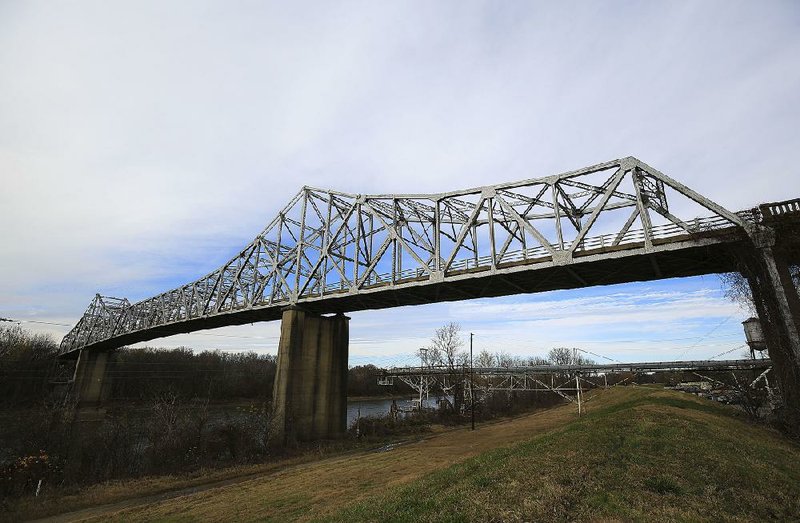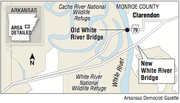The state highway department will not tear down the historic White River Bridge in Clarendon -- at least, for now.
Pulaski County Circuit Judge Chris Piazza on Wednesday asked officials to hold off until a hearing in February, and they agreed.
Arkansas Deputy Attorney General Monty Baugh told Piazza that the state Department of Transportation is under legal obligation to federal authorities to tear down the old bridge. If that order is not carried out, he said, the state could end up having to repay up to 80 percent of the $60.8 million it took to construct a new bridge.
Baugh provided a copy of a letter sent Tuesday from Angel Correau, division administrator with the Federal Highway Administration, saying that the state agency "must fully comply" with the order despite pending lawsuits.
Failure to comply could lead to actions by the federal agency, "such as repayment of Federal Funds previously expended to construct the new U.S. Highway 79 bridge and other associated activities for the removal of the old Highway 79 bridge and structures," Correau said in the letter.
Although the state Transportation Department opened bridge-demolition bids on Jan. 17, it has not yet awarded a contract for the project. Century Construction Group of Tupelo, Miss., submitted the lowest of four bids -- $11.3 million.
Last week, eight Monroe County residents asked the circuit court to temporarily halt demolition of the 87-year-old bridge until a lawsuit filed last summer in federal court to save the bridge can run its course.
When Piazza suggested a 30-day stay until all court responses could be submitted and a hearing held, Baugh objected to a preliminary injunction order but said work would not start on the bridge in the next 30 days.
"There's no possible way," Baugh said.
Robert Keller Jackson, the attorney for the Monroe County residents, asked for an order forbidding the awarding of the bid to the contractor. Baugh objected, saying that the agency will award the contract but will not issue a work order until after the next court hearing.
Piazza agreed.
In 2007, Clarendon and the highway department signed an agreement with the U.S. Fish and Wildlife Service to demolish the old bridge in exchange for the new one. The bridges run through parts of the 68,993-acre Cache River National Wildlife Refuge and the 160,756-acre Dale Bumpers White River National Refuge.
The deal is intended to balance out the ecological impact and flood plain of the area. Instead of having two bridges through the bottomlands, the old one would be torn down and the area below it would be replanted in hardwood trees.
The state and federal lawsuits claim that the agreement constitutes an illegal exaction under Arkansas' Constitution and is, therefore, invalid. In order to get approval for the new bridge, the state highway department gave 147 acres valued at $404,000 to the U.S. Fish and Wildlife Service. In exchange, the federal agency granted a 49.69-acre easement valued at $104,500 -- a difference of nearly $300,000.
"There are no facts at all under which the highway department has expended illegal funds," Baugh told Piazza.
Baugh argued that the ones filing the legal actions were not the same officials who made the initial deal.
"The parties knew exactly what they were doing," Baugh said.
The Department of Transportation has no choice but to follow through with the contract, even if it means removing a historic bridge, he said.
"The highway department is in the business of building bridges; not tearing them down," Baugh said.
The fight to save the old bridge began in 2013 when two Monroe County brothers, John Moore IV and Jeremiah Moore, joined forces with city officials and others -- eventually becoming the Friends of the Historic White River Bridge. The plan would turn the nearly 3-mile structure into the longest-elevated biking and pedestrian trail in the world. Currently, that title is held by the 1.25-mile Walkway Over the Hudson in Poughkeepsie, N.Y.
Jackson argued that the old Clarendon bridge "wasn't hurting anything" and described the natural beauty of the bridge as it winds its way through the treetops of the wildlife refuges.
Piazza smiled and said, "I'm old enough to have driven it hundreds of times." The judge then joked about possibly finding the elusive ivory-billed woodpecker -- believed to be extinct and the subject of an intensive yearlong search by researchers.
"I am convinced he has moved to Clarendon," Jackson said.
Piazza gave the parties two weeks to file written arguments and scheduled the next court date for 1:30 p.m. on Feb. 27.
Jackson called Wednesday's hearing a victory.
"I'm looking forward to the next hearing," he said afterward. "It's all been moving way too fast. This is our effort to slow it down."
Metro on 01/25/2018

